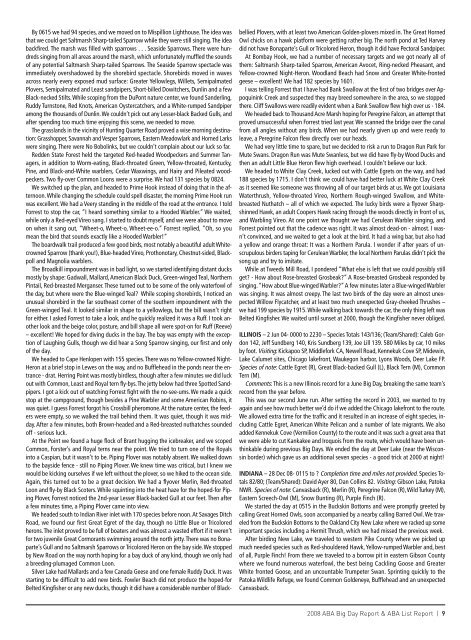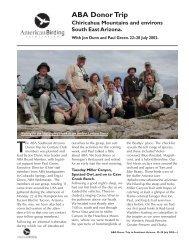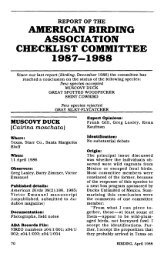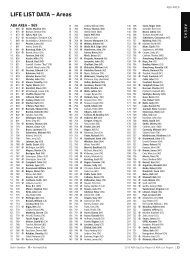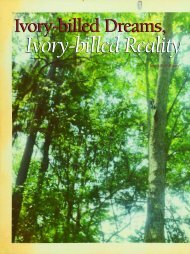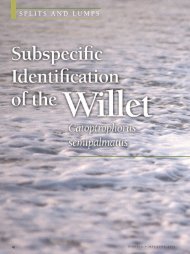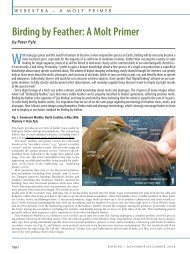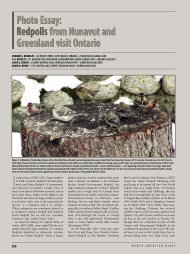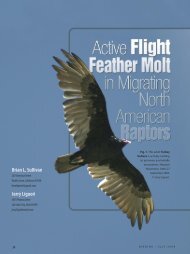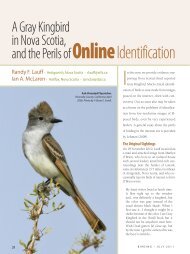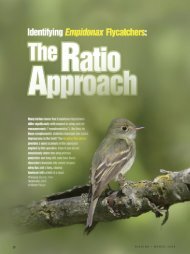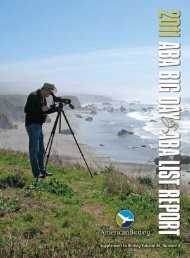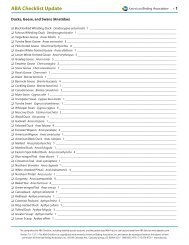Front End - American Birding Association
Front End - American Birding Association
Front End - American Birding Association
You also want an ePaper? Increase the reach of your titles
YUMPU automatically turns print PDFs into web optimized ePapers that Google loves.
By 0615 we had 94 species, and we moved on to Mispillion Lighthouse.The idea was<br />
that we could get Saltmarsh Sharp-tailed Sparrow while they were still singing.The idea<br />
backfired. The marsh was filled with sparrows . . . Seaside Sparrows. There were hundreds<br />
singing from all areas around the marsh, which unfortunately muffled the sounds<br />
of any potential Saltmarsh Sharp-tailed Sparrows. The Seaside Sparrow spectacle was<br />
immediately overshadowed by the shorebird spectacle. Shorebirds moved in waves<br />
across nearly every exposed mud surface: Greater Yellowlegs, Willets, Semipalmated<br />
Plovers, Semipalmated and Least sandpipers, Short-billed Dowitchers, Dunlin and a few<br />
Black-necked Stilts.While scoping from the DuPont nature center, we found Sanderling,<br />
Ruddy Turnstone, Red Knots, <strong>American</strong> Oystercatchers, and a White-rumped Sandpiper<br />
among the thousands of Dunlin.We couldn’t pick out any Lesser-black Backed Gulls, and<br />
after spending too much time enjoying this scene, we needed to move.<br />
The grasslands in the vicinity of Hunting Quarter Road proved a wise morning destination:<br />
Grasshopper, Savannah and Vesper Sparrows, Eastern Meadowlark and Horned Larks<br />
were singing. There were No Bobolinks, but we couldn’t complain about our luck so far.<br />
Redden State Forest held the targeted Red-headed Woodpeckers and Summer Tanagers,<br />
in addition to Worm-eating, Black-throated Green, Yellow-throated, Kentucky,<br />
Pine, and Black-and-White warblers, Cedar Waxwings, and Hairy and Pileated woodpeckers.<br />
Two fly-over Common Loons were a surprise. We had 131 species by 0824.<br />
We switched up the plan, and headed to Prime Hook instead of doing that in the afternoon.While<br />
changing the schedule could spell disaster, the morning Prime Hook run<br />
was excellent. We had a Veery standing in the middle of the road at the entrance. I told<br />
Forrest to stop the car, “I heard something similar to a Hooded Warbler.” We waited,<br />
while only a Red-eyed Vireo sang. I started to doubt myself, and we were about to move<br />
on when it sang out, “Wheet-o, Wheet-o, Wheet-ee-o.” Forrest replied, “Oh, so you<br />
mean the bird that sounds exactly like a Hooded Warbler!”<br />
The boardwalk trail produced a few good birds, most notably a beautiful adult Whitecrowned<br />
Sparrow (thank you!), Blue-headed Vireo, Prothonotary, Chestnut-sided, Blackpoll<br />
and Magnolia warblers.<br />
The Broadkill impoundment was in bad light, so we started identifying distant ducks<br />
mostly by shape: Gadwall, Mallard,<strong>American</strong> Black Duck, Green-winged Teal, Northern<br />
Pintail, Red-breasted Merganser. These turned out to be some of the only waterfowl of<br />
the day, but where were the Blue-winged Teal? While scoping shorebirds, I noticed an<br />
unusual shorebird in the far southeast corner of the southern impoundment with the<br />
Green-winged Teal. It looked similar in shape to a yellowlegs, but the bill wasn’t right<br />
for either. I asked Forrest to take a look, and he quickly realized it was a Ruff. I took another<br />
look and the beige color, posture, and bill shape all were spot-on for Ruff (Reeve)<br />
– excellent! We hoped for diving ducks in the bay. The bay was empty with the exception<br />
of Laughing Gulls, though we did hear a Song Sparrow singing, our first and only<br />
of the day.<br />
We headed to Cape Henlopen with 155 species.There was no Yellow-crowned Night-<br />
Heron at a brief stop in Lewes on the way, and no Bufflehead in the ponds near the entrance<br />
- drat. Herring Point was mostly birdless, though after a few minutes we did luck<br />
out with Common, Least and Royal tern fly-bys.The jetty below had three Spotted Sandpipers.<br />
I got a kick out of watching Forrest fight with the no-see-ums. We made a quick<br />
stop at the campground, though besides a Pine Warbler and some <strong>American</strong> Robins, it<br />
was quiet. I guess Forrest forgot his Crossbill pheromone.At the nature center, the feeders<br />
were empty, so we walked the trail behind them. It was quiet, though it was midday.<br />
After a few minutes, both Brown-headed and a Red-breasted nuthatches sounded<br />
off - serious luck.<br />
At the Point we found a huge flock of Brant hugging the icebreaker, and we scoped<br />
Common, Forster’s and Royal terns near the point. We tried to turn one of the Royals<br />
into a Caspian, but it wasn’t to be. Piping Plover was notably absent. We walked down<br />
to the bayside fence - still no Piping Plover. We knew time was critical, but I knew we<br />
would be kicking ourselves if we left without the plover, so we hiked to the ocean side.<br />
Again, this turned out to be a great decision. We had a flyover Merlin, Red-throated<br />
Loon and fly-by Black Scoters.While squinting into the heat haze for the hoped-for Piping<br />
Plover, Forrest noticed the 2nd-year Lesser Black-backed Gull at our feet. Then after<br />
a few minutes time, a Piping Plover came into view.<br />
We headed south to Indian River inlet with 170 species before noon.At Savages Ditch<br />
Road, we found our first Great Egret of the day, though no Little Blue or Tricolored<br />
herons.The inlet proved to be full of boaters and was almost a wasted effort if it weren’t<br />
for two juvenile Great Cormorants swimming around the north jetty.There was no Bonaparte’s<br />
Gull and no Saltmarsh Sparrows or Tricolored Heron on the bay side.We stopped<br />
by New Road on the way north hoping for a bay duck of any kind, though we only had<br />
a breeding-plumaged Common Loon.<br />
Silver Lake had Mallards and a few Canada Geese and one female Ruddy Duck. It was<br />
starting to be difficult to add new birds. Fowler Beach did not produce the hoped-for<br />
Belted Kingfisher or any new ducks, though it did have a considerable number of Blackbellied<br />
Plovers, with at least two <strong>American</strong> Golden-plovers mixed in. The Great Horned<br />
Owl chicks on a hawk platform were getting rather big. The north pond at Ted Harvey<br />
did not have Bonaparte’s Gull or Tricolored Heron, though it did have Pectoral Sandpiper.<br />
At Bombay Hook, we had a number of necessary targets and we got nearly all of<br />
them: Saltmarsh Sharp-tailed Sparrow, <strong>American</strong> Avocet, Ring-necked Pheasant, and<br />
Yellow-crowned Night-Heron. Woodland Beach had Snow and Greater White-fronted<br />
geese – excellent! We had 182 species by 1601.<br />
I was telling Forrest that I have had Bank Swallow at the first of two bridges over Appoquinink<br />
Creek and suspected they may breed somewhere in the area, so we stopped<br />
there. Cliff Swallows were readily evident when a Bank Swallow flew high over us - 184.<br />
We headed back to Thousand Acre Marsh hoping for Peregrine Falcon, an attempt that<br />
proved unsuccessful when Forrest tried last year. We scanned the bridge over the canal<br />
from all angles without any birds. When we had nearly given up and were ready to<br />
leave, a Peregrine Falcon flew directly over our heads.<br />
We had very little time to spare, but we decided to risk a run to Dragon Run Park for<br />
Mute Swans. Dragon Run was Mute Swanless, but we did have fly-by Wood Ducks and<br />
then an adult Little Blue Heron flew high overhead. I couldn’t believe our luck.<br />
We headed to White Clay Creek, lucked out with Cattle Egrets on the way, and had<br />
188 species by 1715. I don’t think we could have had better luck at White Clay Creek<br />
as it seemed like someone was throwing all of our target birds at us. We got Louisiana<br />
Waterthrush, Yellow-throated Vireo, Northern Rough-winged Swallow, and Whitebreasted<br />
Nuthatch – all of which we expected. The lucky birds were a flyover Sharpshinned<br />
Hawk, an adult Coopers Hawk racing through the woods directly in front of us,<br />
and Warbling Vireo. At one point we thought we had Cerulean Warbler singing, and<br />
Forrest pointed out that the cadence was right. It was almost dead-on - almost. I wasn’t<br />
convinced, and we waited to get a look at the bird. It had a wing bar, but also had<br />
a yellow and orange throat: It was a Northern Parula. I wonder if after years of unscrupulous<br />
birders taping for Cerulean Warbler, the local Northern Parulas didn’t pick the<br />
song up and try to imitate.<br />
While at Tweeds Mill Road, I pondered “What else is left that we could possibly still<br />
get? - How about Rose-breasted Grosbeak?” A Rose-breasted Grosbeak responded by<br />
singing. “How about Blue-winged Warbler?”A few minutes later a Blue-winged Warbler<br />
was singing. It was almost creepy. The last two birds of the day were an almost unexpected<br />
Willow Flycatcher, and at least two much unexpected Gray-cheeked Thrushes –<br />
we had 199 species by 1915.While walking back towards the car, the only thing left was<br />
Belted Kingfisher. We waited until sunset at 2000, though the Kingfisher never obliged.<br />
ILLINOIS – 2 Jun 04- 0000 to 2230 – Species Totals 143/136; (Team/Shared): Caleb Gordon<br />
142, Jeff Sundberg 140, Kris Sundberg 139, Joe Lill 139. 580 Miles by car, 10 miles<br />
by foot. Visiting: Kickapoo SP, Middlefork CA, Newell Road, Kennekuk Cove SP, Midewin,<br />
Lake Calumet sites, Chicago lakefront, Waukegon harbor, Lyons Woods, Deer Lake FP.<br />
Species of note: Cattle Egret (R), Great Black-backed Gull (L), Black Tern (M), Common<br />
Tern (M).<br />
Comments: This is a new Illinois record for a June Big Day, breaking the same team’s<br />
record from the year before.<br />
This was our second June run. After setting the record in 2003, we wanted to try<br />
again and see how much better we’d do if we added the Chicago lakefront to the route.<br />
We allowed extra time for the traffic and it resulted in an increase of eight species, including<br />
Cattle Egret, <strong>American</strong> White Pelican and a number of late migrants. We also<br />
added Kennekuk Cove (Vermilion County) to the route and it was such a great area that<br />
we were able to cut Kankakee and Iroquois from the route, which would have been unthinkable<br />
during previous Big Days. We ended the day at Deer Lake (near the Wisconsin<br />
border) which gave us an additional seven species - a good trick at 2000 at night!<br />
INDIANA – 28 Dec 08- 0115 to ? Completion time and miles not provided. Species Totals<br />
82/80; (Team/Shared): David Ayer 80, Dan Collins 82. Visiting: Gibson Lake, Patoka<br />
NWR. Species of note: Canvasback (R), Merlin (R), Peregrine Falcon (R),Wild Turkey (M),<br />
Eastern Screech-Owl (M), Snow Bunting (R), Purple Finch (R).<br />
We started the day at 0515 in the Buckskin Bottoms and were promptly greeted by<br />
calling Great Horned Owls, soon accompanied by a nearby calling Barred Owl. We traveled<br />
from the Buckskin Bottoms to the Oakland City New Lake where we racked up some<br />
important species including a Hermit Thrush, which we had missed the previous week.<br />
After birding New Lake, we traveled to western Pike County where we picked up<br />
much needed species such as Red-shouldered Hawk,Yellow-rumped Warbler and, best<br />
of all, Purple Finch! From there we traveled to a borrow pit in eastern Gibson County<br />
where we found numerous waterfowl, the best being Cackling Goose and Greater<br />
White fronted Goose, and an uncountable Trumpeter Swan. Sprinting quickly to the<br />
Patoka Wildlife Refuge, we found Common Goldeneye, Bufflehead and an unexpected<br />
Canvasback.<br />
2008 ABA Big Day Report & ABA List Report | 9


